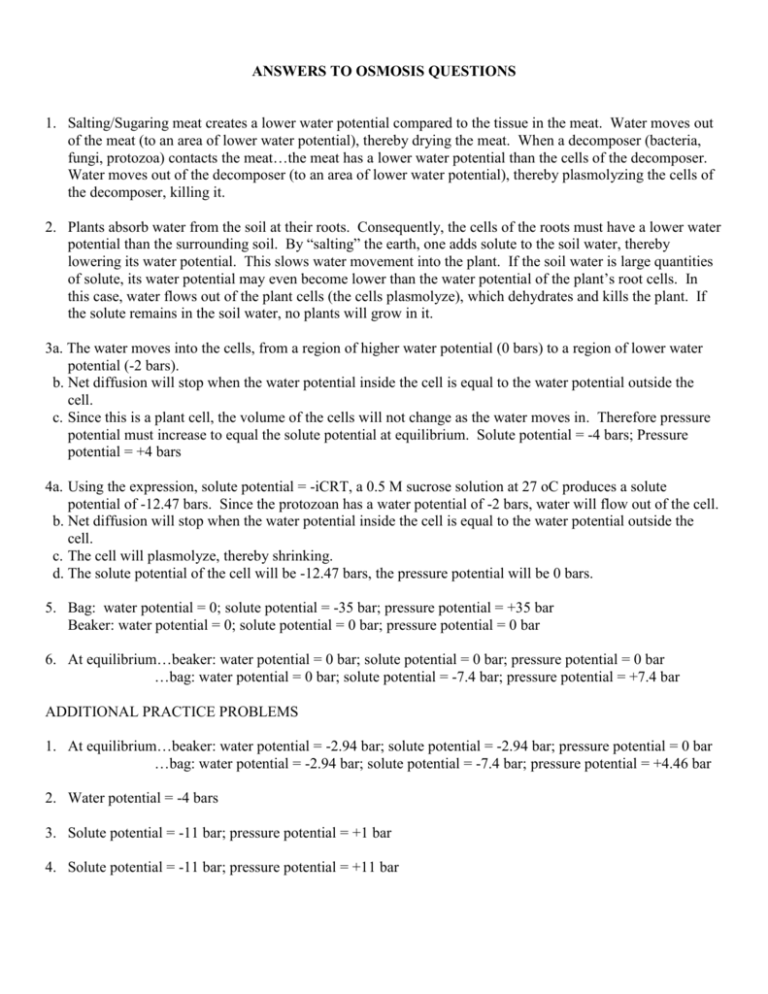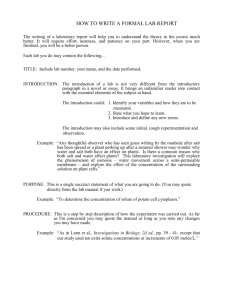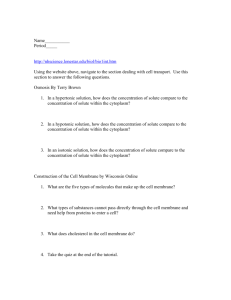ANSWERS TO OSMOSIS QUESTIONS - H
advertisement

ANSWERS TO OSMOSIS QUESTIONS 1. Salting/Sugaring meat creates a lower water potential compared to the tissue in the meat. Water moves out of the meat (to an area of lower water potential), thereby drying the meat. When a decomposer (bacteria, fungi, protozoa) contacts the meat…the meat has a lower water potential than the cells of the decomposer. Water moves out of the decomposer (to an area of lower water potential), thereby plasmolyzing the cells of the decomposer, killing it. 2. Plants absorb water from the soil at their roots. Consequently, the cells of the roots must have a lower water potential than the surrounding soil. By “salting” the earth, one adds solute to the soil water, thereby lowering its water potential. This slows water movement into the plant. If the soil water is large quantities of solute, its water potential may even become lower than the water potential of the plant’s root cells. In this case, water flows out of the plant cells (the cells plasmolyze), which dehydrates and kills the plant. If the solute remains in the soil water, no plants will grow in it. 3a. The water moves into the cells, from a region of higher water potential (0 bars) to a region of lower water potential (-2 bars). b. Net diffusion will stop when the water potential inside the cell is equal to the water potential outside the cell. c. Since this is a plant cell, the volume of the cells will not change as the water moves in. Therefore pressure potential must increase to equal the solute potential at equilibrium. Solute potential = -4 bars; Pressure potential = +4 bars 4a. Using the expression, solute potential = -iCRT, a 0.5 M sucrose solution at 27 oC produces a solute potential of -12.47 bars. Since the protozoan has a water potential of -2 bars, water will flow out of the cell. b. Net diffusion will stop when the water potential inside the cell is equal to the water potential outside the cell. c. The cell will plasmolyze, thereby shrinking. d. The solute potential of the cell will be -12.47 bars, the pressure potential will be 0 bars. 5. Bag: water potential = 0; solute potential = -35 bar; pressure potential = +35 bar Beaker: water potential = 0; solute potential = 0 bar; pressure potential = 0 bar 6. At equilibrium…beaker: water potential = 0 bar; solute potential = 0 bar; pressure potential = 0 bar …bag: water potential = 0 bar; solute potential = -7.4 bar; pressure potential = +7.4 bar ADDITIONAL PRACTICE PROBLEMS 1. At equilibrium…beaker: water potential = -2.94 bar; solute potential = -2.94 bar; pressure potential = 0 bar …bag: water potential = -2.94 bar; solute potential = -7.4 bar; pressure potential = +4.46 bar 2. Water potential = -4 bars 3. Solute potential = -11 bar; pressure potential = +1 bar 4. Solute potential = -11 bar; pressure potential = +11 bar





